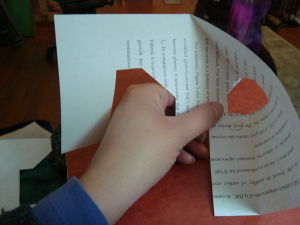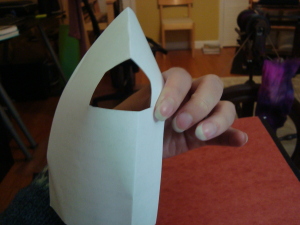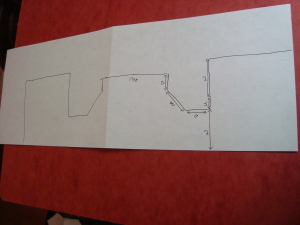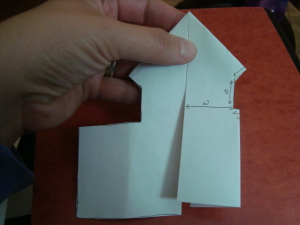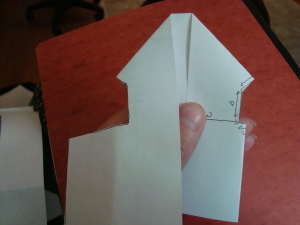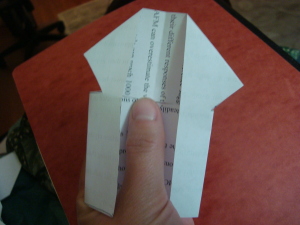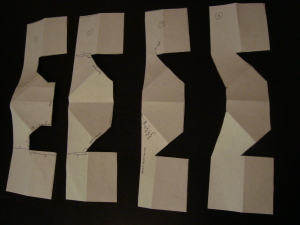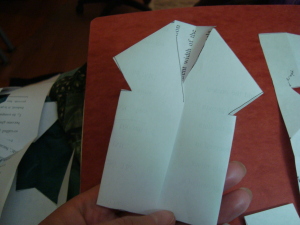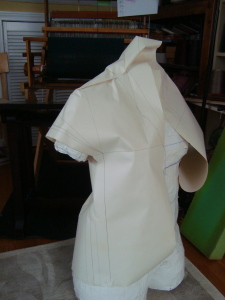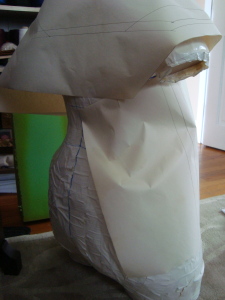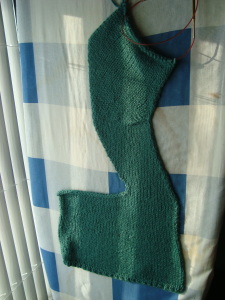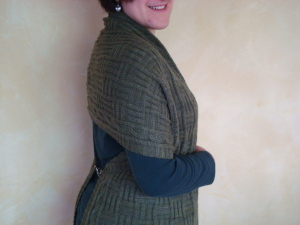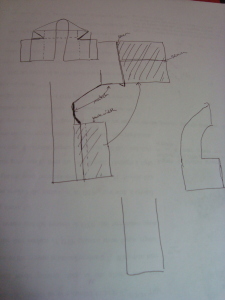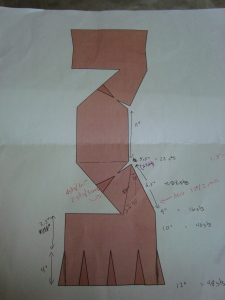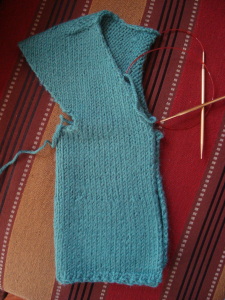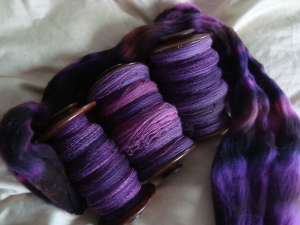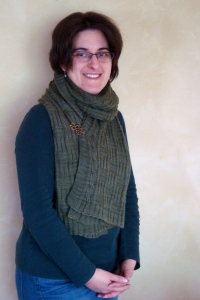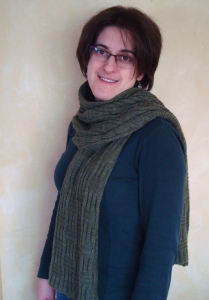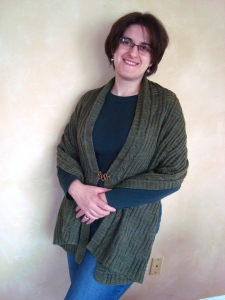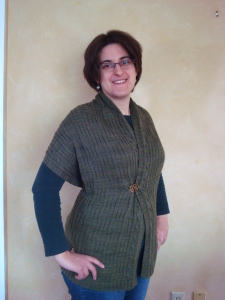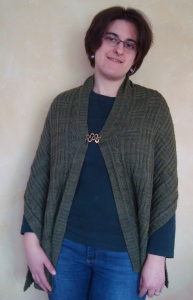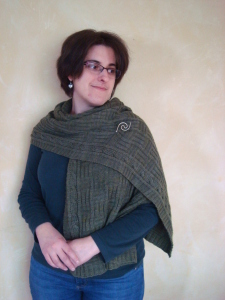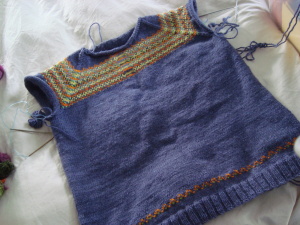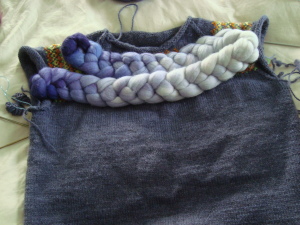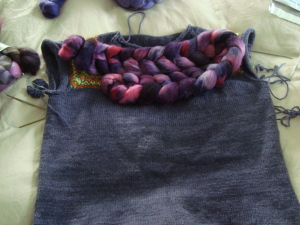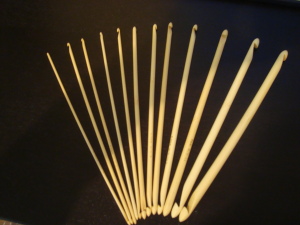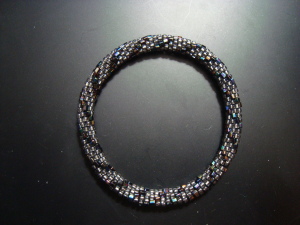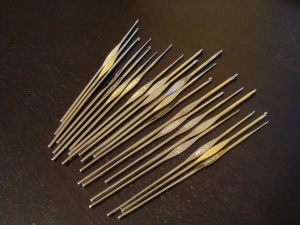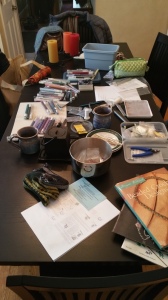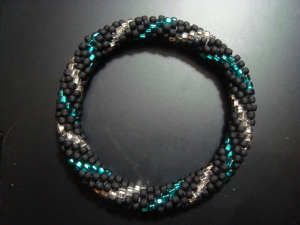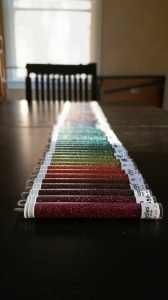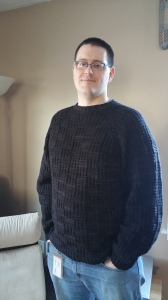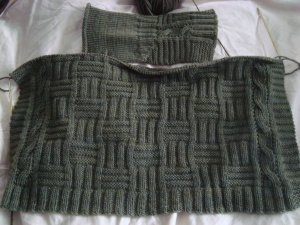It’s been a while since my last purely process post. Shall we go for a wander?
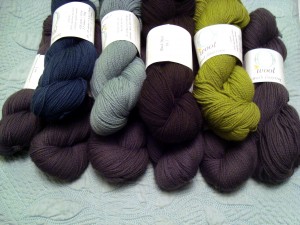
In between other things, I’ve been knitting up a swatch of the O-Wool yarn that I bought at Rhinebeck last year.
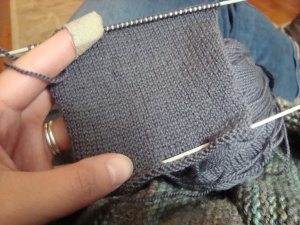
(That swatch is the base color, and both photos are pretty accurate renditions of its color in different lights. It’s a moody yarn.) It’s knitting up at about 10 stitches and 13 rows per inch on size 0 needles (before washing), which makes this sweater a crazy project even for me. But I love the fabric that it makes, and I’m not in any particular hurry, so I may as well settle in and knit.
I know that I am going to include colorwork, but the rest of the sweater has been very slow to take shape in my mind. I’ve been petting the yarn and working on the swatch all month, and I’m still not really sure what I want. I was thinking of a wide shawl collar or a wide colorwork accent band, but other than that I don’t really have any ideas in place yet. (You’ll note that I haven’t swatched any colorwork…that’s because I haven’t quite figured out where I’m heading.)
Today, I took advantage of an unexpected snow day to start thinking through some sketches.
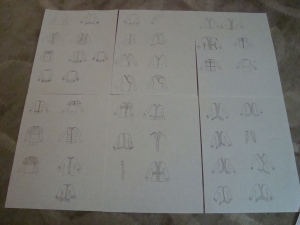
To my surprise, I didn’t really like any of the shawl collar sketches, but I was drawn to a related, more kimono-like design.
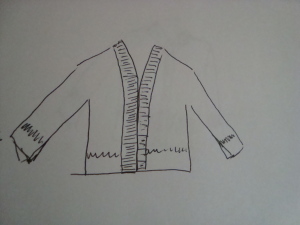
This version kept the wide garter bands in the front, but the neck placement makes this a flat collar rather than a stand-up shawl collar. Though I love the loose fit and drape of kimonos on other people, I tend to prefer something a little less blocky on myself. So I thought about how I might add some shape.
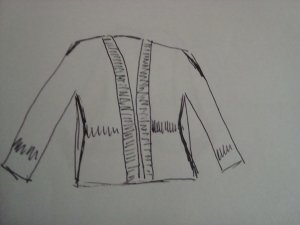
That was still looking a little bit squat and baggy, especially in the shoulders. So, I tightened up the shoulders and made the body a little longer, using the colorwork pattern at the waist almost like a belt.
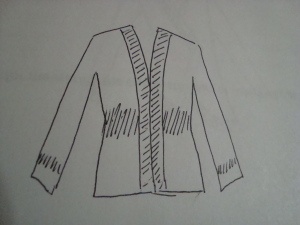
That was definitely getting better, but there’s no reason not to play a bit with sketches, so I thought I’d see what else I could do with this design.
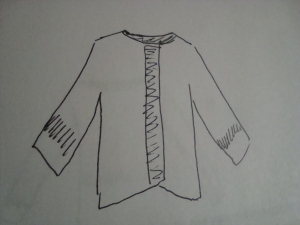
This one definitely leans back toward boxy, and puts the accent on the hemline and center panel, which would presumably be some kind of colorwork.
Adding in a wide colorwork border and adding just a tiny bit of shaping helped with the design.
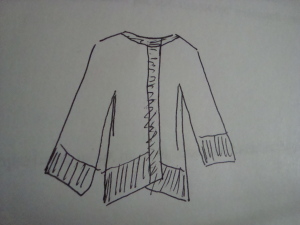
I thought about doing a tied-on-the-side version.
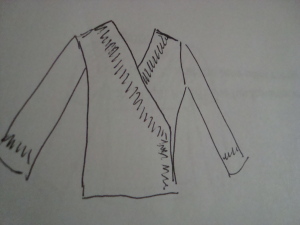
And I tried mixing that with the original shawl collar. I still don’t like it, but it was the best of the shawl collar designs.
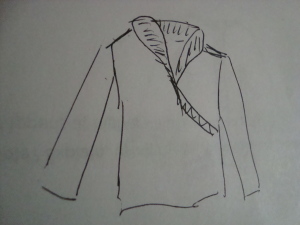
I have a friend who has been trying to convince me that I should knit more asymmetric things. (I love how they look on others, but never wear them myself, so I don’t tend to go there in my designing…) So, I tried a slightly asymmetric hemline.
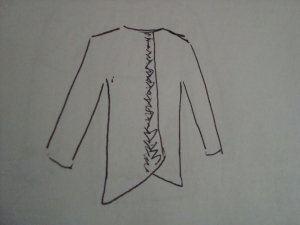
And then I tried bell sleeves and rounded edges.
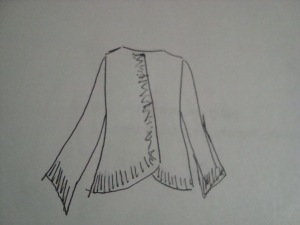
I did like the asymmetric design quite a lot (at least on paper), and the shaping would make for a cross between an A-line and an hourglass, which could be flattering.
I tried a cropped, non-asymmetric version with straight sleeves, which I didn’t really like at all (at least for this garment).
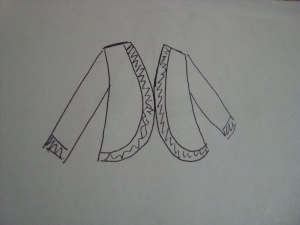
So I inverted the hemline curvature to see if I liked that.
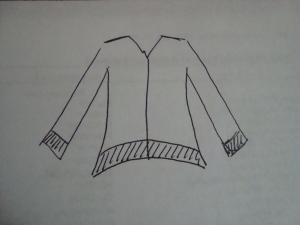
That felt a little too hip-heavy, so I added back the interesting front cross to see if that would help.
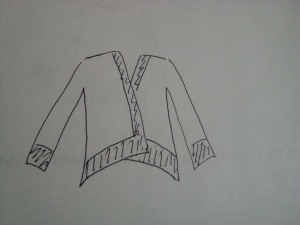
I do like that much better, but I still don’t think it’s a style that would flatter my shape. Just for the heck of it, I also tried some mixtures of the two hemline curves:
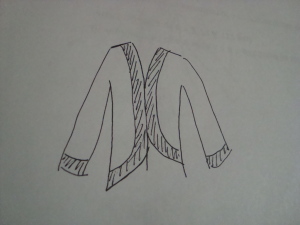
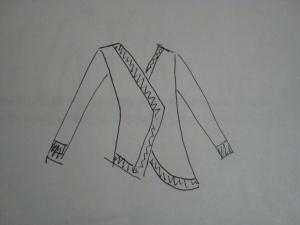
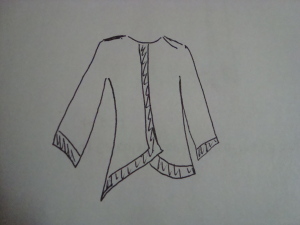
I do really like those, especially the last two. Somewhere along the way, I also tried mixing a flat and a pointed hem, but this was quickly eliminated as a very hip-highlighting design. (Would be a nice A-line shape for someone who wanted a little more emphasis on the hips, though.)
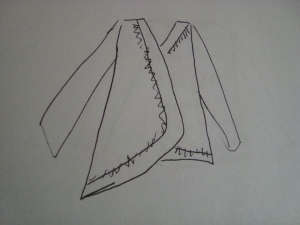
Looking at the sketch again, it might actually be the location of the point that’s problematic here; the triangle point lines up with the widest point of the hip, and then the straight hem emphasizes its width. Reworking that placement might help the design a lot.
I really liked this next one, but not for someone with hips (do we sense a theme here?). I’d really want the waistline to stretch down with no flare, and that only works if you have wide shoulders and narrow hips (which I do not).
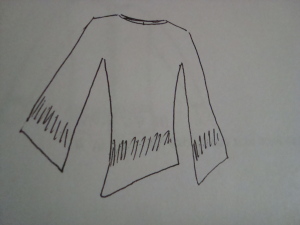
I also stumbled across this interesting cardigan somewhere along this train of thought. It won’t work for this project, since I’m not looking for large blocks of color, but it might be worth exploring in a future design.
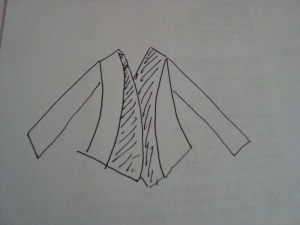
And look how much it changes when you adjust the order of the color panels! That could be fun to play with someday.
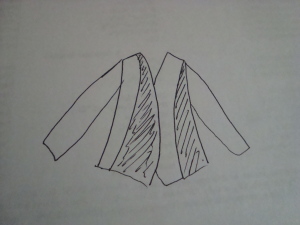
I also drew out quite a lot of the more basic designs. (I’m presenting these sketches as if my train of thought were linear, but it’s really anything but. Circular is more like it!)
A simple, classic pullover with a wide colorwork accent band.
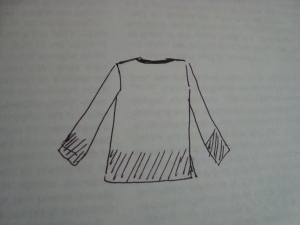
A tunic version with a square neckline and a slit on the sides.
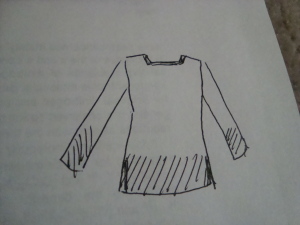
A slightly boxier cardigan with a front-only colorwork panel and a colorwork “belt” across the back.
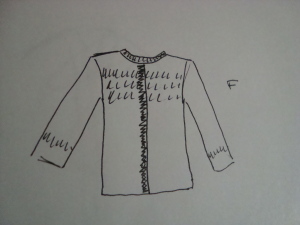
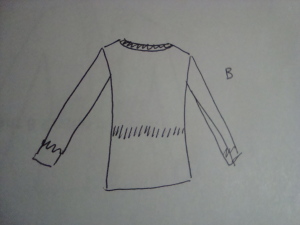
(That back design could actually stand on its own as the front of a garment, too. The simple hourglass shaping in this drawing is one that usually works well for me.)
This is a poorly-drawn version of the same design, with an allover colorwork pattern instead of a single band.Â
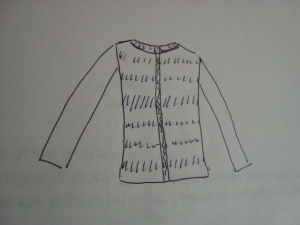
Or you could put the colorwork down at the hem.
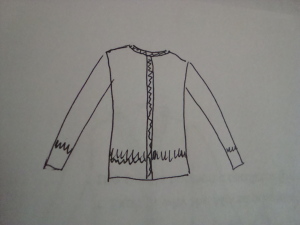
(The astute and long-reading among you might recognize a flavor of the Fall Colors sweater in this particular set of sketches. I do really like that design…)
Almost all of the sketches I’ve shown so far really assume set-in sleeves. I’ve focused on those because I liked the set-in sleeves better, but I did try out a traditional yoke design, too (think Bohus).
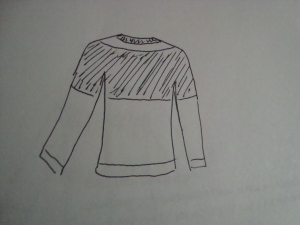
And I thought about a raglan, since it worked so well in my Seafoam sweater.
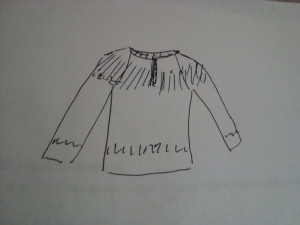
I didn’t like the raglan here, though. It works well for a heavy weight weekend sweater, but somehow it doesn’t feel quite right for a delicate laceweight design.Â
So, what have I learned from all these sketches? Well, for one thing, I have a lot of options! Second, it is clear that I like the set-in sleeves better, which is too bad, since it would be nice to knit this as a one-piece, top-down sweater. (Colorwork in the round and infinite rows of knitting are my preference, instead of knitting flat.) Still, I think the fit of the set in sleeves will work better here, and the extra seams will probably add some stability to the piece. I suppose there’s also the advantage that each piece will be smaller, so at least there will be fewer stitches per row!
I Â notice that I also prefer designs with a longer body, and several of the asymmetric designs have a very loose fit. Bell sleeves and swooping curves mean extra fabric, which I’ll have to reconcile with my yarn supply. I bought way more yarn than I think I’ll need, but I haven’t knit anything this big at such a small gauge before.
I’m not quite sure how to calculate yardage for a sweater knit at this gauge, but here’s my best attempt. (If you’re not interested in sweater guesstimation, you might want to just gloss over this paragraph and the next…) I’d have to do an awful lot of knitting to get an accurate weight measurement to calculate the yards per inch from a swatch, so I’d rather compare to other projects and extrapolate from there: I knit a 3.5 st/in bulky sweater out of about 900 yards of yarn, and a 7.5 sts/in sweater with 1500 yards of yarn. By this estimate, I’d put a 10 sts/in sweater in the 2000-2200 yards range.
I might get a more accurate guesstimate from a finished project at a similar gauge. My spiral shawl took about 770 yards of yarn, and it was about 8 sts/in for a similar weight yarn. A very conservative estimate places the final shawl at about 600 square inches, or 0.78 square inches per yard (ignoring the lace border, which has a different gauge). I have 2568 yards of the base color for this sweater: at the same yards per square inch as the spiral shawl, I’d get about 2000 square inches of knitted fabric. If I overestimate a sweater as a plain rectangle, it’s about 44 inches at the hem and 23 inches tall, which is 1012 square inches for the body. The sleeves take roughly the same amount of yarn as the body, so 2000 square inches should be about right for a blocky sweater of average length. I’ll get some yardage back from the shaping and the colorwork, and I’ve padded all of my numbers by about 10% to make my guesstimate more conservative, so I’m pretty sure I’ll have enough yarn.
Even so, I probably won’t have tons and tons of extra yardage to work with, so I’m not sure I want to go adding in a lot of extra fabric, just in case.
So, still more to ponder before I’m ready to settle on a design. I do want to start playing around with the colorwork, too; choosing a pattern might help narrow down the possibilities a bit. For now, I think this project will continue to simmer away on the back burner. Fortunately, I have a couple more skeins of scarf knitting before I’m out of projects again!
